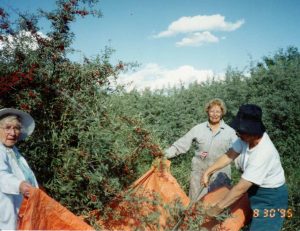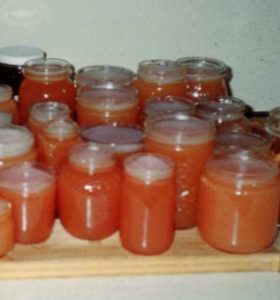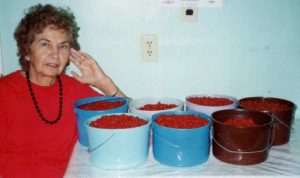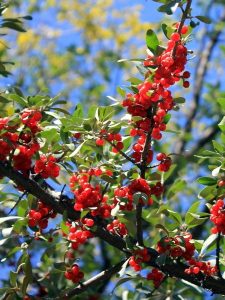Buffaloberry – A Super Fruit
The buffaloberry (Shepherdia canadensi), also known as bulberry, soopolallie, soapberry or foamberry, is a old/new super fruit that grows in every province across Canada (except PEI) and also the western and northern United States. The buffaloberry bush grows one to four metres high in open forests and thickets and has slim grey-green leaves. It can also be bought at tree nurseries.
A 2013 article in The Journal of Food Science says the buffaloberry may be the next superfruit. Researchers found the tiny red, slightly sour fruits are rich in lycopene (also found in tomatoes) which is an antioxidant that appears to lower the risks of certain cancers. The berry is both bitter and sweet and has been compared to coffee sweetened with sugar. It contains saponin which has great foaming capacities. Buffaloberries are high enough in sugar to taste good as a fresh or dried fruit (they have the consistency of a raisin when dried) and their acidity makes them desirable for wine makers.
The Nlaka’pamux (Thompson), St’at’imc (Lillooet) and Secwepemc (Shuswap) collect soap berries and process them as sxusem (“sxushem”, also xoosum/”hooshum”) or soap berry whip, also called “Indian Ice Cream”. In a 1989 article in British Columbia Historical News a story told by Marianne Kinbasket describes a custom based on soap berry whip:“The hostess puts soap berry juice in a dish and whips it with a wad of soft grass. When thick her guests sit all around her and start eating it from the dish with forked sticks. If they have enough to eat of it – all is well. But if it begins to look low and they know that there is not going to be enough to satisfy their appetite, the air gets thick and uncomfortable. The hostess, if she’s quick enough, suddenly leaps away from the group and runs for her life. If they catch her they rub her face and head with her grass whipper and crown her with her dish. Her screams, the noise and laughter, one can imagine!”
Sandra Konrad of Edmonton says she may be one of the few people in her city who makes buffaloberry jelly (which her family calls bulberries). Here is her recipe and some prized photos of her mother and aunts collecting the berries.
Bulberry Jelly – Sandra Konrad
- Kn
 ocking berries off trees makes for a debris-strewn pi
ocking berries off trees makes for a debris-strewn pi ck.
ck. - I started with 10 cups cleaned and ready-to-cook bulberries
- – Added 5 cups water, which almost covers them
- – Strained through a tight cotton, not cheesecloth which would allow too much sludge into the juice
- Yield 6 cups juice
- – A
 dded 4 cups sugar ( a recipe online said ¾ cup sugar to 1 cup juice)
dded 4 cups sugar ( a recipe online said ¾ cup sugar to 1 cup juice) - – Boiled it up.
- – Yielded five 1-cup jars of jelly.
- Looks like I could have boiled it a bit longer, but it was sheeting properly so….
[Note: wax is not recommended for sealing jars of jelly. Bernardin recommends high-heat processing for high acid foods such as jams, jellies and even pickles].
The Internet has many more recipes for buffaloberries. Look around your neighbourhood for a buffaloberry bush that may be waiting for you to discover it and enjoy this true Canadian fruit.
References:
Dehart, S. (1989. Marianne & Amelia Kinbasket. British Columbia Historical News. 22 (1), 13- 18.

